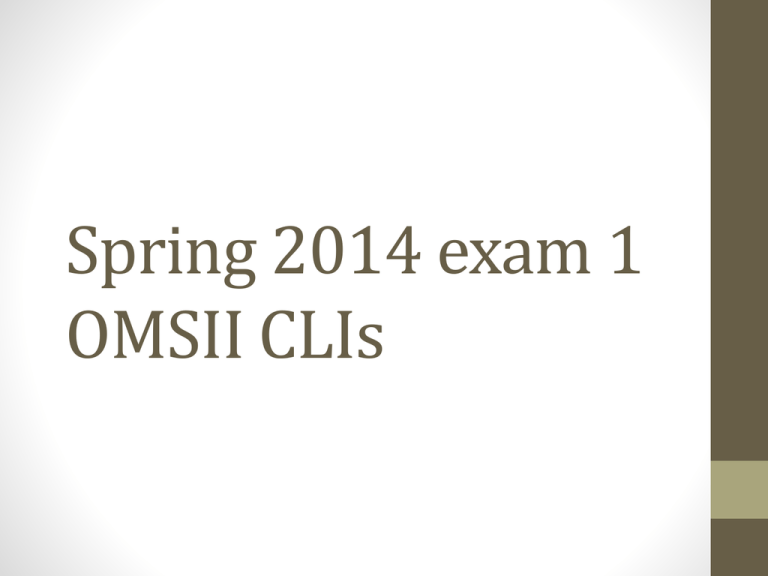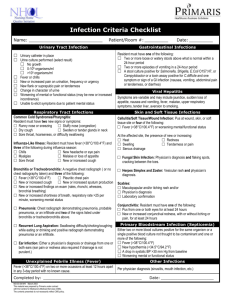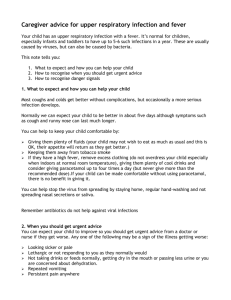Spring Exam 1 OMSII CLIs 1-30
advertisement

Spring 2014 exam 1 OMSII CLIs Rickettsiae • Pathogen: • Obligate intracellular bacteria (i.e. Cannot be grown on artificial media) and are not resolved by light microscopy. Note: Rickettisiae Giemsa stain (1st AID) • Small gram negative rods, however not readily stainable by gram stain • Encounter: • Zoonoses • The distribution of various rickettsiae tends to be geographically limited and dependent on the distribution of suitable arthropod (tickes, mites, fleas, lice, and chiggers) vectors or animal reservoirs. • Entry: • Humans usually acquire infection by arthropod bites • Except: Coxiella burnetii may be acquired by inhalation (cattle/sheep birth products) and other routes. Not arthropods. • Symptoms of Rocky Mountain spotted fever begin about a week after inoculation • Replication & spread: • The organisms have a predilection for vascular endothelial cells, causing blood vessel damage and bleeding in various organs. In the skin, vascular damage results in rashes. • Coxiella burnetii grows in Macrophages • Ehrlichiosis grow in leukocytes. Rickettsiae • Damage: • Rickettsiae can cause several severe diseases: • Rocky Mountain spotted fever (Rickettsia rickettsii) - Most important in the USA, eastern and southern states transmitted by the Dermacentor spp of tick (not ixodes), vasculitis - infection of the blood vessel endothelium can lead to encephalitis, pneumonitis, cardiac arrhythmia, nausea, vomiting, and abdominal pain. • • • • • • • • Rash on palms and soles of feet. Triad: Headache, Fever, rash (1st AID) Typhus (R. prowazekii) [From the human body louse feces on skin] Murine typhus (R. typhi), Scrub typhus (Orientia tsutsugamushi), Q Fever, which manifests as pneumonia and chronic endocarditis [Coxiella burnetii ] - granulomas, no rash Human monocytotropic ehrlichiosis and human granulocytotropic anaplasmosis both infect leukocytes and cause thrombocytopenia. Diagnosis: • Depends on clinical suspicion and acumen, since laboratory studies are seldom helpful in establishing a diagnosis during the acute stage. • Laboratory confirmation is usually achieved in the convalescent stage by demonstrating a fourfold or greater rise in the titer of antibodies to rickettsial antigens. Treatment and prevention: • Rickettsial infections can be treated with antibiotics that penetrate into host cells. • Doxycycline DOC. • Sulfa drugs actually seem to exacerbate both spotted and typhus fevers. Penicillins, aminoglycosides do not affect the course of rickettsial diseases. Rickettsiae Table 28-1 Etiology and Epidemiology of Prinicpal Rickettsioses Rickettsial Agent Diseases Reservoir in Nature Transmissio n Geographic Distribution Rickettsia rickettsii Rocky Mountain spotted fever Ticks (transovarian transmission) Tick bite North and South America Rickettsia conorii Boutonneuse fever Ticks (transovarian transmission) Tick bite Southern Europe, Africa and Asia Rickettsia prowazekii Epidemic typhus Humans, flying squirrels Louse feces Potentially world wide Recrudescent typhus (Brill-Zinsser disease) Humans None caused by reactivation Potentially world wide Rickettsia typhi Murine typhus Fleas and rats Flea feces Worldwide, especially in the tropics and subtropics Orientia tsutsugamushi Scrub typhus Chiggers (transovarian transmission) Chigger bite Asia, Oceania, and northern Australia Ehrlichia chaffeensis Human monocytotropic ehrlichiosis Deer, goats, dogs Tick bite North America, Africa, Asia Anaplasma phagocytophilum Human granulocytotropic anaplasmosis Deer, elk, wild rodents Tick bite North America and Eurasia Coxiella burnetii Q fever Cattle, sheep, goats, other livestock, cats Aerosol from infected birth Worldwide Campylobacter jejuni • Pathogens: • • • Gram negative rod One of the most common causes of diarrhea in the USA Comma or S-shaped, Oxidase positive (1st AID) • Encounter: • • Main reservoir is gastrointestinal system of animal. Farm animals, usually transmitted by poultry. Pathogens are usually transmitted to humans in contaminated food (e.g. raw eggs). • Spread and multiplication: • • In the gastrointestinal tract, organisms face formidable defenses. Pathogen access to the small and large intestine requires passage through the highly acidic stomach. In the small intestine, organisms adhere to the epithelia cells of the tract via pili (fimbriae) or surface adhesins. Note that virtually all gram-negative bacteria possess type 1 or common pili. • Damage: • • • • • Diarrhea, watery (bloody) diarrhea, ileum, colon. Major cause of bloody diarrhea, esp in children (1st AID) Large intestine Tissue invasion, inflammatory pathology Fever Complication- Guillain-Barre syndrome • • Also reactive arthritis (1st AID) Can occasionally cause dysentery • Diagnosis: • Stool culture • Treatment : Macrolide (e.g. erythromycin) when invasive or for pt’s in carrier state Bacteriodes • Pathogen: • • • • Encounter: • • • • Inflammation of sensitive sites after entry of organisms from intestinal oral flora, Zwitterionic polysaccharide capsule. Host response contributes to abscess formation. Abscesses (e.g. peritoneum, lungs) often part of mixed flora • Bacteroides fragilis toxin – is metalloprotease that disrupts tight junctions of epitherial cells by cleaving E-cadherin Diagnosis: • • Large numbers of bacteria can enter the sterile peritoneal cavity if the bowl wall is breached through rupture, appendicitis, or abdominal surgery. Infection often begins with peritonitis and bacteremia, which can be followed by intra-abdominal abscess formation. Damage: • • Among the numerous intestinal Bacteroidales species, Bacteroides and Parabacteroides species are the most commonly isolated from clinical infections. With Bacteroides fragilis comprising approximately 50% of clinical, intestinally derived Bacteroidales isolates. Spread and Multiplication: • • Normal flora Bacteroidales are commensal/symbiotic bacteria of the human intestines but become opportunistic pathogens if they gain access to otherwise sterile peritoneal cavity following leakage of colonic contents. Entry: • • Gram negative rods Strict Anaerobes Bacteriodaes are an order of bacteria containing several genera including Bacterioides, Parabacteroides, Prevotella, and Alistipes which include species that are members of the human clolonic microbiota. Bacteroidales species are collectively the most abundant gram negative bacteria of the human colonic microbiota reaching densities greater than 10^10 bacteria/g of colonic contents. Imaging methods, such as ultrasound or CT are used to identify and localize abscesses. Anaerobic culture or PCR methods can identify particular species and determine antibiotic sensitivities. Treatment and prevention: • • Abscesses are treated by drainage and antibiotics; antibiotic therapy effective against both facultative anaerobes and strict anaerobes is necessary, with particular attention to the resistance profile of Bacteroidales species. Metronidazole, (DOC) B-lactam-B-lactmase inhibitor combinations, carbapenems. Clindamycin resistance is very common. Human Prion Disease • Pathogens: • Prions consist of a pathologic isoform of a normal host protein. They contain no nucleic acid. Prion protein PrPc normally primarily alpha helix • The “infectious agent” is an abnormally folded, degradation-resistant form of the PrPc protein PrPsc mostly beta sheets • Encounter: • Prion diseases may occur as sporadic, iatrogenic, hereditary, or transmissible diseases. They include Creutzfeldt-Jacob disease (CJD), variant CJD (“mad cow disease”, Bovine Spongiform encephalopathy). Kuku (Papua New Guinea, cannibalism) Only Kuku and variant CJD are thought to be acquired predominantly exogenously. Gerstmann-StrausslerScheinker (GSS) syndrome. Fatal familial insomnia (FFI). • Avg age of onset of CJD is 65 years, variant CJD is 30 • Nearly all patients tested to date with variant CJD are homozygous for methionine at codon 129 in PrPc • GSS: Autosomal dominant with complete penetrance. Presents with progressive cerebellar degeneration accompanied by various degrees of dementia in patients entering midlife (avg age 45). Mean survival 5 years. • FFI: rapidly fatal midlife disease mean survival 13 months. Progressive insomnia, often associated with a dreamlike confessional state during waking hours. Inattention memory loss confusion and hallucinations occur. But overt dementia is rare. Myoclonus ataxia and spasticity can occur late in the disease. Dysautonomia (hyperhidrosis, hyperthermia, tachycardia, and hypertension) and endocrine disturbances decreased adrenocorticotropic hormone secretion increased cortisol secretion and disturbances in growth hormone melatonin and prolactin, • Entry: • Dura mater transplants and injections of human pituitary extracts account for most iatrogenic cases. • Spread and multiplication: • Prions do not multiply in the conventional sense. Instead, they increase in number by inducing a conformational change in the related normal host protein so that the latter assumes the prion isoform. These progressive changes occur primarily in the CNS. • Progression to developing the CJD from growth hormone was found to be 8-12 years. From contaminated neurosurgical equipment it was 18months. Human Prion Disease • Damage: • • • • Accumulation of prions in the CNS is usually associated with dementia, abnormal movements, ataxia, and neuropsychiatric features. CJD: rapidly progressive dementia and myoclonus, hyperkinesia , cerebellar signs and hyperreflexia. Most cases present with visual, cerebellar, thalamic or striatal signs and symptoms. Attentional problems, memory loss and judgment difficulties are frequently early signs. Variant CJD: prominent sensory disturbances and psychotic symptoms. Cognitive impairment, involuntary movements, immobility, paresis of upward gaze, unresponsiveness, and mutism are common signs as the disease advances. Plaques have an eosinophilic center and a pale periphery and are often surrounded by spongiform changes. Cerebellum is commonly involved in variant CJD, but only occasionally affected in sporadic CJD. Avg survival 5 months CJD, 14 months variant CJD • Diagnosis: • • • • Diagnosis depends on clinical features and neuropathological findings. Small vacuoles within the neuropil which produces a spongiform appearance. Neuronal loss, glial cell proliferation in absence of inflammatory response. CJD: CSF elevated 14-3-3 protein level may be a potential diagnostic test. Although it reflects brain cell death in general. EEG with a periodic synchronous biphasic or triphasic sharp wave complexes. CT usually normal. MRI is more informative increased T2 signaling the putamen and head of the caudate. Variant CJD: in non neural tissue detection of PrPsc useful for diagnosis . • Treatment of prevention: • Sporadic diseases cannot be prevented, but transmission of prions can be avoided by special decontamination procedures for neurosurgical equipment or neural tissues used therapeutically. Gardnerella • Pathogen: • Gardnerella vaginalis • Gram variable (1st AID puts it in Gram-Positive column with variable written next to it) • Encounter: • Asymptomatic or symptomatic disruption of the normal vaginal flora characterized clinically by a malodorous vaginal discharge. The normally dominant colonizing lactobacilli are markedly reduced, while a variety of species increase in numbers. • Damage: • Bacterial vaginosis – characterized by overgrowth of certain bacteria. • Noninflammatory (1st AID) • From 1st AID: • Gray vaginal dischage, with fishy odor, positive whiff test • Associated with sexual activity, but not an STD • Clue cells, or vaginal epithelial cells covered with bacteria are visible under microscope • Treatment: Metronidazole Borrelia • Pathogen: • Lyme disease is caused by the spiral-shaped bacterium (spirochete) Borrelia burgdorferi. • Borrelia infection in North America is limited to B. burgdorferi. But all species are significant source of lyme disease in Europe and Asia. • Giemsa stain • Encounter: • Wild animal reservoir, transmitted to humans via tick bite. Deer tick = Ixodes sp. • Entry: • The initial infection is characterized by the hallmark erythema migrans or bull’s eye rash that expands out from the tick bite site. • Spirochete transmission to the host typically does not occur until day 3 of feeding • Spread and multiplication: • Lyme disease is a multistage disease that spread from the tick bite site to infect the skin, joints, heart, eyes, CNS, and other tissues. Signs and symptoms can be intermittent. • Can cause heart block (1st AID) • Some preference for attachment to brain gangliosides. Common symptom is facial nerve palsy, frequently bilateral (1st AID) • Damage: • The host immune response to the B. burgdorferi infection causes injury to the host tissues. • Diagnosis: • diagnosis is based on the presence of erythema migrans and antibodies against B. burgdorferi, along with a history that suggests exposure to infected ticks. • Confirmation can be done with serology ELISA or immunoblot • Treatment and prevention: • Lyme disease is effectively treated with antibiotic therapy if detected early. Doxycyline in adults and amoxicillin in children 2 to 4 weeks. CNS involvement usually treated with 3rd generation cephalosporin drugs (e.g. Cefatrixone). • Currently no vaccines. Norovirus • Pathogen: • • • • • • • Encounter: • • • • GI tract, diarrhea and vomiting. Generally mild and self limited. Can last from 24-48 hours. Small intestine. Villous blunting in ileum and proximal jejunum with intact intestinal mucosa has been seen on biopsy from volunteers. Leading cause of viral gastroenteritis in adults and 2nd leading cause of severe disease in children. Diagnosis: • • • Susceptibility to norovirus infection and disease is based on histoblood group antigen expression (e.g. blood type and secretor status). Nonsecretors are immune, and B blood group are less likely to become infected or develop symptomatic infection. Damage: • • • • Usually do not invade the intestinal mucosa or spread to other organs. Replication: • • • Transmitted by the fecal-oral route, usually by person-to-person contact but also by ingestion of food or water. Spread: • • Are associated with disease in diverse settings, including schools and childcare centers, nursing homes, vacation settings (e.g. camps and cruise ships), military ships and maneuvers, restaurants and catered meals, and hospitals. Have a peak incidence in the winter months in the North America. Year round occurrence Explosive outbreaks Entry: • • Calicivirus ssRNA (+) No envelope Caspid- icosahedral Cannot be cultivated Short-term immunity only (6-26 weeks) ELISA of ddx outbreaks but not individuals. . RT-PCR of vial RNA in stools. Treatment: • Viral gastroenteritis is not treatable by any specific therapy; rather, treatment is supportive to provide and maintain hydration. Histoplasma • Organism: • • • • Encounter and entry: • • • Soil, bird, and bat droppings (nitrogen enriched) Geography: Mississippi and Ohio River Valleys, Central America, and some areas of South America Spread and multiplication: • • • Histoplama capulatum, a mold that grows in soil. Transforms into a yeast after being inhaled into the alveoli Endemic mycoses Mold that produces macro (tuberculate) conidia and microconidia, the infectious form. In the body transforms into a yeast. Inhaled and transforms into yeast. Yeasts are phagocytosed by macrophages and neutrophils but killing is problematic Immune response takes weeks and the organism spreads locally through the lymphatics to the hilar and mediasitnal lymph nodes and then hemtogenously within macrophages throughout the reticuloendothelial system. Damage: • • • • • • • • • Histoplasmosis – clinical features Fever, chill, dry cough, weight loss, chronic pulmonary infiltrate with or without cavities Patchy pneumonitis and hilar or mediastinal lymphadenopathy on chest x-ray. Patients with COPD are at risk for developing chronic cavitary pulmonary histoplasmosis. A progressive and eventually fatal infection that mimics reactivation tuberculous. Lungs, reticuloendothelial system, mucous membranes Immunity depends on Tcells and activated macrophages Causes both acute and chronic forms of pulmonary and disseminated disease. Cell mediated immune response is reflected in the development of granulomas with or without caseation necrosis. And a positive skin test to Histoplasma antigens. Ultimately most granulomas calcify. And yeast can remain viable within granulomas for years. Acute disseminated histoplasmosis is characterized by fever, chills, mucous membrane ulcers, hepatosplenomegally, and pancytopenia. In some cases, adrenal insufficiency and sepsis syndrome and DIC. Chronic progressive disseminated histoplamosis is seen in older adults who have no obvious immune deficiency. Histoplasma • Diagnosis: • Growth in vitro can take up to 6 weeks and is not successful in many laboratories. • Histopathological demonstration of the small intracellular nests in samples from bone marrow, liver, lung or lymph nodes using special stains is rapid and highly suggestive of histoplasmosis. • Polysacchride antigen can be detected by ELISA in urine or serum. In most patients with disseminated infection and some with primary pulmonary histoplamosis, but very few with localized and chronic forms of the disease. Will not be present in immunocompromised hosts. • Treatment: • Treated with amphotericin B for severe disease and itroconazole for mild-to-moderate disease 3-12 months • Prevent by using respirators when doing demolition of areas that may contain bird or bat feces. Trichinella • Pathogens: • Helminths that invade tissues • round worms • Trichinella spiralis • Encounter: • Trichinosis is maintained by a “cycle of carnivorism” in which predators and scavengers feed on each other and acquire larvae encysted in muscles. Humans usually acquire infection from undercooked meat from pigs or carnivorous game animals. • Entry: • Ingesting encysted larvae contaminated food. Larvae hatch in intestine, mature to adults and release larvae that invade the intestinal wall and enter the bloodstream. The larvae then encyst in striated or cardiac muscle. • Spread and damage: • Trichinella larvae disseminate from the intestine and encyst in skeletal muscles; fever, severe muscle pain and intense eosinophilia occur when larvae disseminate to human skeletal muscles • Mild infection produces malaise, mild diarrhea, and periorbital edema; severe infection may be life threatening with CNS involvement. • Larvae can be present in the heart, skeletal muscle, brain, or GI tract • Most infected people are asymptomatic • Larvae encyst in muscle and produce a marked initial inflammatory response. The cysts usually calcify, although the worms can remain viable for up to 30 years. • Incubation times depends on larvae load (2-3 days to 10 days) Trichinella • Diagnosis: • visualizing from body fluids or tissues. • Serologic assays cannot distinguish a new infection from a past one, but is useful for diagnosis of visitors to an endemic region. • Rise in antibody titer is diagnostic. Typically occurs 3-4 weeks after infection. • In severely ill patients, muscle biopsy • Treatment/Prevention: • Treatment of trichinosis may shorten the course of illness by killing adult worms in the intestine to prevent ongoing larval dissemination. • Prevention of acquisition, treatment of carriers and blocking the return of parasites to the environment are strategies for interrupting the cycles of helminth transmission. • Early stages of infection anthelmintic drugs Albendazole, mebendazole kill adult parasites in intestine and may prevent ongoing production of invasive larvae. However later, they are of little use against the encysted larval forms and may actually provoke symptoms. Bed rest and anti-inflammatory agents are useful for controlling symptoms. Corticosteroids have been used in severely ill patients with myocarditis and/or encephalitis Missing HIV








